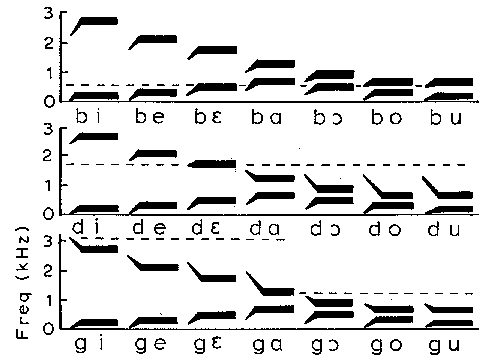Acoustics of consonants
Fricatives
The turbulent airstream created during fricatives gives rise to a
constantly changing, chaotic spectrum. On a spectrogram, a
fricative will appear much like static on a TV screen.
While the spectrum of a fricative will be unpredictable for any
given instant, if we look at the average amplitudes over time, we
find patterns that allow us to tell the fricatives apart.
- the strident fricatives, [s] and [
 ], have higher overall
amplitudes than non-strident fricatives like [f] and [
], have higher overall
amplitudes than non-strident fricatives like [f] and [ ].
].
- the average spectrum for [s] has more amplitude at higher
frequences than [
 ] has.
] has.
See Rogers, figure 9.18
The average spectrum is often used to give visual feed-back
during the treatment of lisping.
Oral stops
A voiceless oral stop blocks off all airflow through the vocal
tract and has no vibration of the vocal cords. The closure phase
of a voiceless oral stop is silence. This will show up as a
blank region on a spectrogram.
Since the closure phases of all voiceless oral stops are
identical, in order to tell vowels apart on a spectrogram we have
to pay attention to the properties of the approach phase and the
release phase (just like listeners have to).
There are two main audible cues for the stop's place of
articulation:
- the release burst: there is a split-second of
turbulence after a stop is released. The average spectrum of
this release burst looks like that of the fricative with the same
place of articulation. For example, [t] on a spectrogram will
appear as a blank space followed by a very brief burst of static
concentrated at higher frequencies just like [s].
- formant transitions: as the vocal tract moves from
its position for the consonant to its position for a following
vowel, there are very brief influences on the formants at the
beginning of the vowel. There are also influences on the
formants at the end of a preceding vowel.
Exaggerated formant transitions for some consonant-vowel
pairs:

This is why unreleased stops are harder to identify. Since they
have no release burst, the listener must rely only on the subtle
influence of the consonant on the formants of the preceding
vowel.
Voiced oral stops will look much like voiceless stops on
spectrograms, except that:
- because there is some vocal cord vibration, there will some
visible darkness in the low frequencies at the bottom of the
spectrogram (often called a "voice bar")
- the release burst will be less pronounced
Next: Acoustic enhancement
Previous: Spectrograms
Up: table of contents
 ], have higher overall
amplitudes than non-strident fricatives like [f] and [
], have higher overall
amplitudes than non-strident fricatives like [f] and [ ].
].
 ] has.
] has.
 ], have higher overall
amplitudes than non-strident fricatives like [f] and [
], have higher overall
amplitudes than non-strident fricatives like [f] and [ ].
].
 ] has.
] has.
